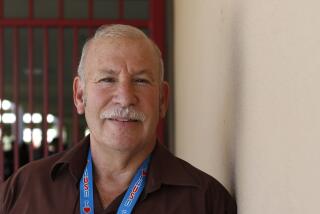District Seeks Space for Charter Campuses, Eastside High School
So much need, so little space.
Officials of the Los Angeles Unified School District on Tuesday wrestled with two issues about the scarcity of land for new campuses: how to comply with a state law requiring districts to provide facilities for charter schools, and where to build a long-needed additional high school on the Eastside.
After much hand-wringing, the school board adopted a policy that its members hope will satisfy largely untested provisions of Proposition 39, a 4-year-old, voter-approved measure that lowered the requirement for passing local school bond issues from two-thirds to 55%, and required districts to accommodate space requests from qualified charter schools.
Charters are public, tax-supported schools that operate independently of the districts in which they are located. They are free from many state requirements, but are expected to be innovative to improve student achievement.
Los Angeles Unified, which is in the middle of a $10-billion program to build more than 100 schools and modernize others to relieve overcrowding, has struggled to satisfy Proposition 39’s requirements while ensuring room for its own students.
The policy approved Tuesday calls for the district to survey its facilities annually and find “reasonably equivalent” buildings or parts of campuses it can offer to charter schools that will enroll at least 80 students from the district.
But the district added many restrictions, including that it would not be required to use general funds to rent, buy or lease a site; that it would retain ownership; and that locations would be made available only on a year-by-year basis.
In addition, no site would be offered to a charter if it would cause crowding within five years in neighboring district schools; nor could it interfere with the district’s plans to implement full-day kindergarten or provide adult education, early childhood education or primary centers.
The board also voted to offer to a charter operator a closed school in the west San Fernando Valley: Highlander Road Elementary. Officials said the district’s eight other closed schools are already leased to other organizations or are expected to reopen soon.
Five or six more sites would be offered for charter schools to share with district schools or other programs, but officials would not disclose the sites, citing upcoming negotiations.
Several board members questioned whether the new policy would hamper the district in providing facilities for its own students.
But Supt. Roy Romer said not adopting the policy would have other risks. “We not only have a state law, but we have an obligation to proceed in good faith in partnership with charter schools,” Romer said.
Noting that the state law is largely untested, he added: “We do not want to cause a lawsuit that we are going to lose.”
Also Tuesday, the district’s space crunch prompted a downtown rally and march by Eastside community activists, students and parents frustrated by the long, controversy-ridden search for land to build a high school in unincorporated East Los Angeles.
Organized by InnerCity Struggle, a Boyle Heights-based group, about 100 protesters gathered outside the Los Angeles County Hall of Administration about 5 p.m. after delivering a letter to Supervisor Gloria Molina, then marched to district headquarters a few blocks away.
The school board already had finished its meeting when marchers arrived, but board member David Tokofsky, whose district includes the Eastside, waited to meet them.
Parents and students have been frustrated by the so-far fruitless search for a new high school site to relieve overcrowding at Garfield High, where more than 4,600 students are jammed into 1925 buildings that operate year-round on multiple tracks.
Marchers on Tuesday urged Molina and Tokofsky to agree to what activists consider the next-best site for a 2,000-student high school: Hammel Street Elementary and some adjacent housing in East Los Angeles. The grade school would be moved.
Tom Calhoun, an official with the district’s facilities program, said the Hammel site is “a plan we are looking at very closely.”
A spokesperson for Molina said she wants to see a district proposal before commenting. Tokofsky said he wants to hear more from the communities affected by the plan.
More to Read
Sign up for Essential California
The most important California stories and recommendations in your inbox every morning.
You may occasionally receive promotional content from the Los Angeles Times.











